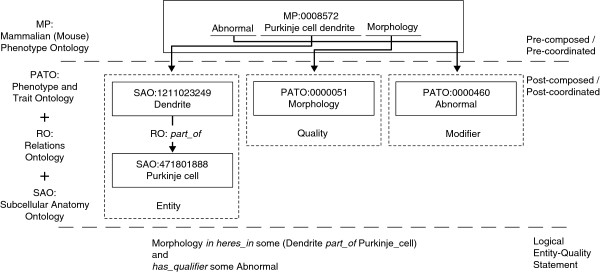Figure 2.

Overview of the three levels of phenotype representation: pre-composed, post-composed and logical entity/quality statements. This figure depicts the high-level process of modeling phenotypes based on diverse levels of logical decomposition. At the most coarse-grained level, we find pre-composed entities, which are usually introduced as monolithic concepts within particular ontologies. In the example, the Mammalian Phenotype Ontology defines MP:0008572 (Abnormal Purkinje cell dendrite morphology). In order to make the trait–localization duality explicit, this entity can be modeled in a post-composed form by an entity/quality association defined by foundational models. Hence, MP:0008572 can be represented by an entity, composed of SAO:1211023249 (Dendrite) and SAO:471801888 (Purkinje cell) - connected via RO:part_of, a quality - defined by PATO:0000051 (Morphology) and, in this particular case, a modifier associated with the quality - PATO:0000460. Subsequently, this model can then be materialized in a logical statement, with the help of additional relationships, such as inheres_in and has_qualifier, as defined in [27].
